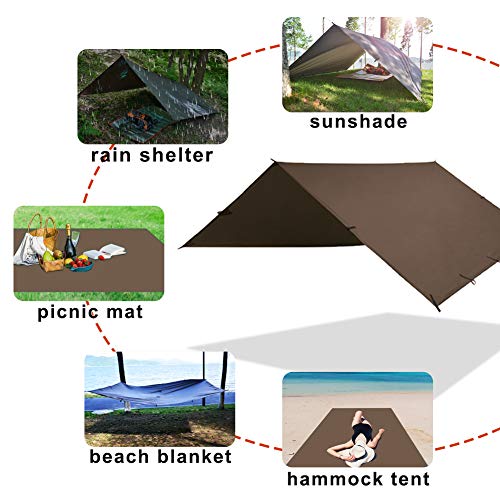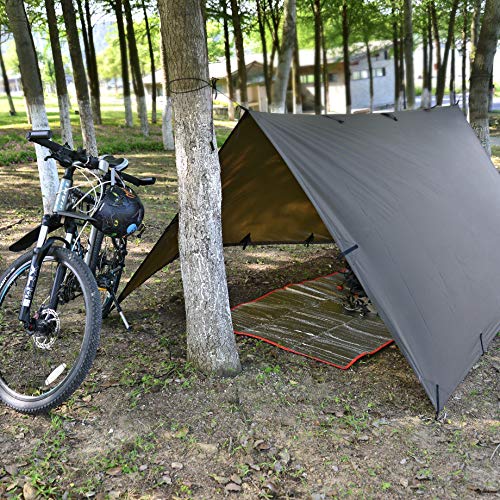Eventually, the strain of carrying a tent with you during every outdoors expedition might start to weigh you down. That’s when a survival tarp can come in handy.
In many instances, a tarp can work as the best shelter for you in the wilderness. It can protect you from storms, the blazing heat, or even from snowfall.
Using a survival tarp is also a great way to challenge yourself to survive in the elements without the complete shelter of an enclosed tent. If you want to become a true survival expert, then a tarp is an essential item you’ll need in your survival backpack.
But how do you go about choosing the best survival tarp for you?
We’ve narrowed down five of the best survival tarps on the market, to help you find one that will give you the best protection. Many of the best survival tarps are multi-purpose too, which is a key feature to look for in any piece of survival equipment.
Take a look at our reviews, and check out our handy buyer’s guide, and you’ll soon be able to find the best survival tarp to shelter you from the elements!
KALINCO Tarp
The KALINCO Tarp is a multi-functional and durable tarp, made from 190T polyester. It has a PU 3000mm waterproof coating, which means it will survive in even harsh rainfall.
It is an ideal survival tarp, as it is both compact and lightweight, easy to carry with you on long journeys. The material is flexible and light, which is great for building shelter, but also makes it easier to fold up into a survival backpack.
It measures at 10x10ft, but also comes in a 10x15ft size. It comes with six stakes, six ropes, and a carry bag for convenience.
It is a multifunctional product, and you can use it not only as shelter, but also for ground use as a tent footprint.
Read the full post_title; ?> review
Pros
- Lightweight and compact
- Durable against abrasions and punctures
- Flexible material
- Budget-friendly
Cons
- Some customers claimed that they still got wet despite the waterproof coating, so it may not be the most reliable in wet weather
Aqua Quest Defender Tarp
Tarps can front as an alternative shelter, ground cover, or even a sleeping bag. That’s why it would be an excellent inclusion to your survival kit.
The Aqua Quest Defender Tarp offers you a 100% waterproof tarp in various sizes, protecting small and more crowded groups from extreme weather.
With a hydrostatic resistance of 20,000 mm, The Defender can guarantee not a single drop of water will get through your tarp.
Again, this tarp caters to both the lone rangers and survival collectives out there with its size range.
The smallest tarp, with a height of 10 x 7 feet, and the most massive tarp, standing at 15 x 15 feet, have weights ranging from 2.4 lbs to 7.2 lbs.
If you’re on the move and need temporary and quick shelter, then it would be wise to acquire this tarp.
Unlike regular tarps on the market, The Defender includes between 19 and 24 reinforced webbing loops, including one in the center. You won’t even need a tree to set up this dark horse.
This product falls on the more expensive side of the spectrum.
However, based on its material, features, and praise within the field, it will be an excellent longterm investment and will increase your survival chances.
Read the full post_title; ?> review
Pros
- 100% Waterproof
- Durable
- Extremely versatile
- Compact
- Includes lifetime warranty
Cons
- Not budget-friendly
- Some customers have reported it being heavier than advertised
Arcadia Gear Survival Tarp
The Arcadia Gear Survival Tarp is described as ‘one of a kind,’ designed to maintain body temperature in both hot and cold weather.
This is due to the thermal reflective aluminized polymer design, which helps to regulate temperature.
As there is such a focus on this tarp’s defense against the elements, you can expect it to be useful in many survival situations.
It is built from polyurethane-treated, rip-stop nylon, which gives it 20,000mm of hydrostatic resistance. It also comes with double stitched heat taped seams, which provides you with a dry shelter even in heavy rainfall.
It weighs 2.25lbs, which is lightweight and means it shouldn’t weigh you down to carry. It packs up into a compact size and fits into it’s 6” x 12” stuff sack, which is also easy to store.
Read the full post_title; ?> review
Pros
- Designed to maintain body temperature
- Durable nylon construction
- Lightweight
- Waterproof
Cons
- Not budget-friendly
Gold Armour Tarp
Measuring at 12ft x 10ft, the Gold Armour Tarp works well for wilderness survival, and can cover a large space.
It is built to last in even torrential downpour and will give you additional protection against strong winds.
It has a square-shaped design, and, at 12ft x 10ft, will cover a large area. It features 33 tie-down loops, so you’ll have plenty of anchoring points to set up your tarp.
This tarp is made from durable rip-stop polyester fabric, and is tear and puncture-resistant, ideal for high-impact scenarios where you need a reliable shelter.
Read the full post_title; ?> review
Pros
- Large size guarantees protection
- Lots of attachment points for easy installation
- Durable material
- Highly waterproof
Cons
- Not the most lightweight tarp
Unigear Tent Tarp
Durability is no issue with the Unigear Tent Tarp.
It is constructed with 210D rip-stop Oxford fabric, which provides great water and tear resistance.
For extra water protection, the tarp’s interior has a PU2000mm waterproof coating. It is UV-resistant, and the design makes it suitable as shade from both the sun and snowfall.
The tarp comes with six adjustable nylon ropes, six aluminum stakes, a sack for the ropes and poles, and a carrying pouch to keep all of your gear safe. The tarp itself has eight tie-down loops and grommets, which gives you plenty of attachment points to secure your tarp in place.
It’s easy to carry and takes minutes to set up, so it is an ideal choice for a survival situation.
Read the full post_title; ?> review
Pros
- Durable material prevents tears and punctures
- Water-resistant
- Suitable for use in all weather conditions
- Easy to set up
- Covers a large area
Cons
- Doesn't pack into the most compact size, so you may struggle to fit it into a backpack
Tarp Material
Survival tarps can come in a variety of materials, each with their own pros and cons. The best survival tarp will be durable and able to withstand many weather conditions and terrains. Let’s take a look at what kind of materials you can expect your tarp to be built from:
Plastic
Plastic, in particular polyethylene plastic, is perhaps the most commonly used material that tarps are made from. Their popularity is for a multitude of reasons, with one being that they are generally a more affordable option.
Polyethylene tarps are multipurpose, and can vastly differ in their durability. Despite this, you’ll usually find that they’re waterproof and UV treated regardless of their overall strength.
They will generally have a layer of polyethylene film, and the more layers are, the more long-lasting the tarp will be.
Nylon
High-quality nylon tarps are known for being lightweight and compact, which is ideal for any survival situation you might face.
They can lean on the more expensive side, as they often have high-end grommets and reinforced material to make them work so well.
Tyvek
Tyvek is a moisture barrier material, often used for construction work. It is relatively budget-friendly and is designed to be highly durable, making it an option worth considering for survival.
Despite its industrial durability, it can be quite a stiff material and make a lot of noise when it’s first used. A stiff tarp is harder to mold into different positions to make versatile shelters, and it is likely to attract attention if it’s noisy.
Visqueen
Similarly to Tyvek, tarps made from Visqueen are designed to create a moisture barrier.
A benefit of Visqueen is its value for money, as you can often get a large piece of tarp for a budget-friendly price.
Both Visqueen and Tyvek don’t come with grommets, which is something to think about beforehand. You’ll need to create your own fastenings instead.
Color
When it comes to choosing the right colored tarp, you’ll need to think about how you plan on using it.
In a survival situation, you’ll likely want to blend in with the wilderness environment to save yourself from attracting potential enemies. With this in mind, think about choosing a tarp in a natural color, such as brown or green.
However, if you are conscious that a disaster could mean you’ll lose your way and you’ll need rescuing, a brighter colored tarp will be a sensible choice. Many plastic tarps come in a blue color, so this could be ideal for you if you’d rather stay safe and attract attention.
An All-Weather Tarp
While it’s easy to assume that all tarps are built to survive whatever the weather, this isn’t always the case.
You must choose a tarp that can withstand a variety of weather conditions. You never know what to predict in the wilderness, even with all the right gear, so having water and wind-resistant equipment is crucial.
You’ll need a tarp that also has breathable material, and won’t suffer under the heat. Make sure to check out the specifications before you choose your tarp, as you don’t want it to crumble on you in unexpected weather conditions.
Your tarp should also be resistant to mildew and rot. When heat and overnight dew combine, this can cause mold or mildew to form. If you’re planning on traveling in a warm area, then this is a particularly important factor to consider.
Size and Shape
Generally, tarps will be rectangular or square-shaped. Rectangular-shaped tarps are great for protection purposes, such as sheltering your sleeping bag or tent. Square tarps are ideal for campsite protection as a whole, but they are generally bigger and therefore take up more space in your survival backpack.
Tarps will vastly differ in size. Because of this, we recommend having a few different tarps in varying sizes, to give yourself a better chance of having a solid shelter.
For an average tent, a 15×15 size tarp will work well to cover it, while a 13×10 tarp is excellent for making your own shelter.
It is also worth noting that some tarps don’t always come true to size. If you think a tarp is on the small side before you purchase it, it may be better to play it safe and go for a tarp that is a few inches bigger than what you think you need.
The reason for this is because some manufacturers will state the tarp’s measurement prior to it being hemmed at the edges, so it is not always reliable.
Attachment Points
Ideally, the best survival tarp will have at least four attachment points. Most tarps will have grommets around the edges.
Grommets are metal rings that allow you to securely tie down the tarp. The spacing between the grommets will differ depending on the size and shape of the tarp. A heavy-duty tarp will usually have grommets that are around 18 inches apart from each other.
Not only does the tarp itself need to be durable, but so do the grommets.
The type of metal used for grommets will either be aluminum, plated steel, or brass. All of these metals are rust-proof, but their strength isn’t all the same.
Aluminum in particular isn’t too strong, and will instead work best in light-duty applications. In contrast, brass is the most durable of the three metals, so it’s worth looking for brass grommets if you want to have the most long-lasting tarp.
Versatility
Tarps may be one of the most versatile pieces of equipment you can have in your survival backpack.
Besides being used for shelter purposes, of course, tarps can make great protective covers to keep items safe, such as firewood. You don’t want your wood to get wet, so keeping it sheltered from the weather is a smart idea.
You can also use a heavy-duty survival tarp to collect water, should you need it for hydration or food preparation. You can use it to trap rain, or even scoop up water and carry it. A good way to collect water would also be to use your tarp as a funnel in a bucket or container, and let rainwater funnel in this way.
When disaster strikes, you never know if you’ll end up stranded in a flood or need to get across large bodies of water. A tarp can work surprisingly well as a floatation device if it is heavy-duty and waterproof.
A strong and sturdy tarp can double as a container for hauling food and items during long journeys. This is extremely convenient in survival situations, where you may need to carry large items over long distances and your backpack is completely full.
Our Pick
Recap
Many emergency and bug-out bags will contain a tarp, and it’s clear to see why. Tarps are so versatile and can help you out when you need it the most.
With a range of tarps to choose from, it’s not always easy to find one that is going to hold up in an intense survival situation. With that in mind, my pick for the best survival tarp is the Aqua Quest Defender Tarp.
This product is of excellent quality, and will withstand all kinds of weather conditions. Durability and reliability are exactly what you need to reap the benefits of this multifunctional piece of survival gear.
Thanks for reading, and we hope that you’ll now be able to choose the best survival tarp for you!
Please leave any feedback in the comments section below. If you have any suggestions for future topics, please get in touch with us via our social media pages, which are linked below. We’d love to hear from you!
Good Luck and Happy Survival Prepping!
Share the Love
If you found this post useful, please let others know about it by sharing it.









































